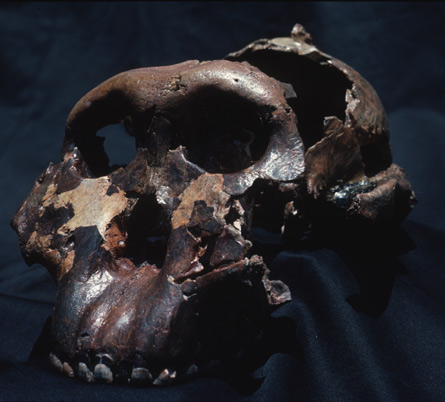Nutcracker Man, a member of the human evolutionary family best known for having massive jaws, peglike teeth and huge chewing muscles, was just an old softy. Although most researchers have assumed that this now-extinct ancestor evolved to eat nuts, seeds and other hard or fibrous foods, it actually favored tender vittles such as nutrient-rich fruits, a new study finds.

Belonging to the species Paranthropus boisei, Nutcracker Man lived from 2.3 million to 1.2 million years ago in East Africa. It represented the final species in a side-branch of human evolution.
No other member of the human evolutionary family evolved choppers that measured up to those of P. boisei. But the first analysis of microscopic marks on fossil teeth shows that this species concentrated on eating soft foods, despite its outsized chewing apparatus, say anthropologist Peter Ungar of the University of Arkansas in Fayetteville and his colleagues.
“We need to reevaluate what we once thought about P. boisei,” Ungar says. “A specialized anatomy can allow a species to avoid the very foods to which it is adapted when other, more preferred resources are available.”
In other words, P. boisei may have evolved its unusual traits as a safety valve so that it could efficiently eat items such as nuts and seeds during tough times. When tastier choices such as fruits became available, they were fair game.
Modern gorillas eat in much the same way, Ungar notes. If given a choice, gorillas typically choose to munch fruit over leaves. Yet these animals display large, sharp teeth designed for ripping leaves apart.
The new study appears online April 30 in PLoS ONE.
Patterns of microscopic wear on P. boisei molars showed virtually no evidence of deep pits or parallel incisions, dental hallmarks of the recent consumption of hard and tough foods. “It looks more like they were eating Jell-O,” Ungar says. Subtle marks on the teeth from eating soft foods probably accumulated for several days before each fossil individual’s death, in his view.
Earlier dental studies indicated that P. robustus, which lived from 2 million to 1.5 million years ago in southern Africa, also resorted to eating hard and tough foods when softer foods weren’t available, Ungar notes. P. robustus had large jaws and teeth, although not as large as those of P. boisei.
The new findings create a puzzle for scientists trying to explain why Nutcracker Man hit an evolutionary dead end. The standard hypothesis that this species evolved to eat such a specialized diet that it perished in nut- and seed-free environments no longer holds up, Ungar concludes.
“This is as good and rigorous a study of P. boisei as we are likely to get,” remarks anthropologist Bernard Wood of George Washington University in Washington, D.C. “It seems that these creatures could eat almost anything except flesh, and in that respect it confounds the hypothesis that they became extinct because they were up a dietary ‘blind alley.’”
Ungar and his coauthors first identified seven of 53 P. boisei molars that preserved clear signs of microscopic wear marks. Those seven specimens, found in Kenya, Tanzania and Ethiopia, spanned a time period of almost 1 million years. The scientists used a special high-powered microscope to create 3-D reconstructions of marks on each tooth.
For comparison, similar molar reconstructions were obtained from two monkey species that usually eat fruit but sometimes opt for nuts and leaves, as well as two other monkey species that eat mostly leaves and other tough foods.
While a larger sample of P. boisei teeth would strengthen the findings, “it’s striking that all seven teeth look the same, especially given their separation in time and geography,” Ungar says.







